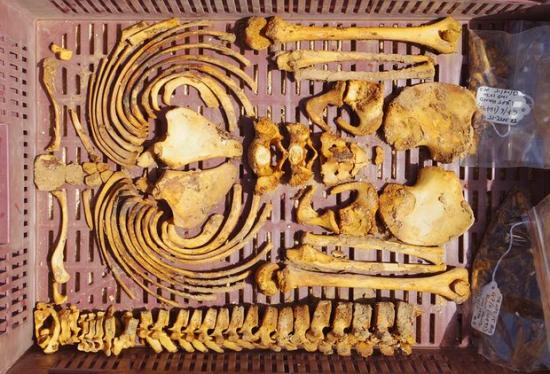PART.2
Who is buried at the North Tombs Cemetery?
This is a difficult question at this early stage of the project and all our current theories have their drawbacks. The North Tombs Cemetery lies towards the main stone quarries and it seems most likely that these people were employed somewhere in the quarrying process as unskilled labour during the frantic construction of the new city.
One possibility is that these are Egyptian children, perhaps demanded from their families as a contribution to the construction of the new city, or singled out in some other way. Corvée-style labour, enforced and unpaid, was frequently used in ancient Egypt on major projects. It is also possible that these were the children of slaves and therefore viewed as more or less disposable. In either case, children seem to have been removed from their families with little intention of them being returned.
 The arms and torso of a juvenile skeleton from the North Tombs Cemetery, packed up all nice and neat after removal from the grave. Photograph: Mary Shepperson/Courtesy of The Amarna Project
The arms and torso of a juvenile skeleton from the North Tombs Cemetery, packed up all nice and neat after removal from the grave. Photograph: Mary Shepperson/Courtesy of The Amarna Project
A further suggestion is that the North Tombs Cemetery may represent a captured or deported population brought to Amarna for labour. This is perfectly possible and would account for the lack of family contact and the apparent disregard shown for young life. On the other hand, there are no indications from the method of burial, the pottery and the few objects recovered to suggest that these people were not Egyptians.
We hope that future DNA analysis of the bones might clarify the geographical origins of the North Tombs Cemetery skeletons.
In any case, the evidence of the North Tombs Cemetery forces us to face the possibility that Akhenaten built his city at least partly with child labour.
For archaeologists, Amarna is both a blessing and a curse for understanding life in New Kingdom Egypt. On the one hand it provides a snap shot of a city of this period, conceived and built from scratch and not altered in later periods. On the other hand, Amarna is awkwardly exceptional in that it was built at great speed under an eccentric pharaoh and his strange new theology, so how representative might it really be?
If the building of Amarna employed child labour, could it have been a more widespread practice for state building projects in New Kingdom Egypt? At present comparable data from other Egyptian sites is very limited. The exceptional nature of Amarna makes it hard to extrapolate these findings from one highly unusual cemetery.
However, Egypt is littered with building projects of extraordinary scale by ancient standards, from pyramids and temples to canals and artificial lakes, commissioned by pharaohs with a similarly megalomaniac mind-set to Akhenaten. Perhaps when we marvel at these wonders of ancient engineering we should spare more thought for the price paid in human lives, some of them only just beginning, which constituted the cost of such high ambitions. Archaeology gives us the means to provide a counter narrative to the pharaonic bombast of the textual records and tell a grimmer tale of hard work and short lives.
All work at Amarna is carried out with the kind permission and support of the Egyptian Ministry of Antiquities. The work at the North Tombs Cemetery is supported with funding from the National Endowment of the Humanities. The Amarna Project is a project of the McDonald Institute for Archaeological Research, University of Cambridge.